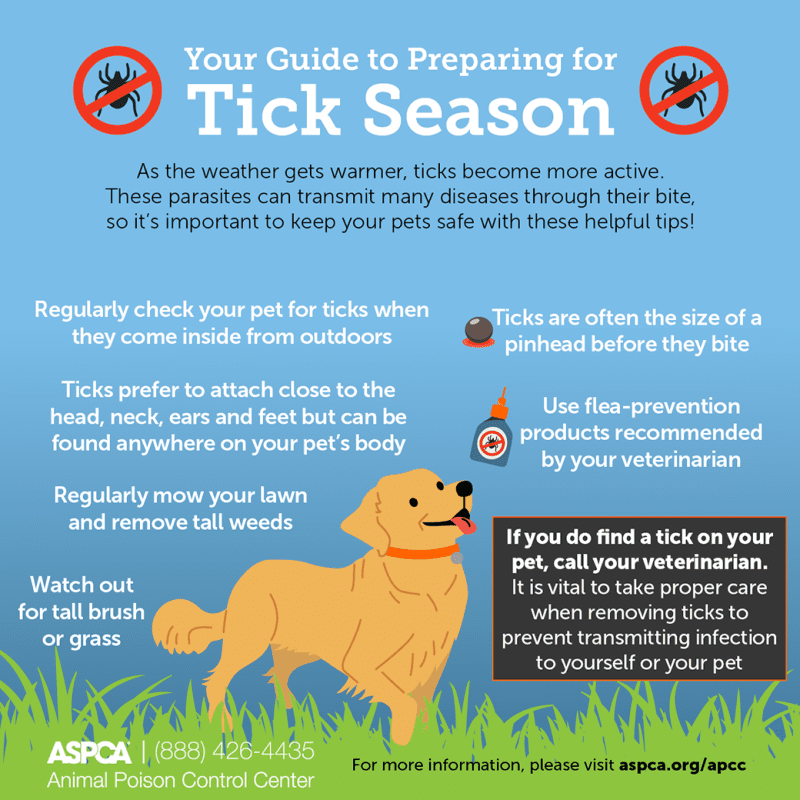
Tick season: how to protect your dog?
With the onset of the warm spring season, not only the earth and trees come to life, but also various insects and parasites, including mites. These parasites can bring a lot of problems to you and your pet. Who are these ticks and what danger do they pose?
Ticks in Russia
Ticks begin to show their activity when the air warms up to 10 ° C. However, it is worth remembering that even in winter on the ground above the heating mains, the temperature is comfortable enough to maintain the activity of ticks. For the most part, these small arthropods can be found in the grass, in very rare cases – on low bushes. In order for you personally to avoid a tick bite, you need to dress properly for walks in the forest or in the park. Clothing must be tight-fitting, with long sleeves and trousers, hair must be covered with a headdress.
On the territory of the Russian Federation, there are many different types of ticks belonging to different families: ixodid, gamas, argasso. The largest family is the ixodid tick. The main dog diseases that these parasites carry are babesiosis (piroplasmosis), ehrlichiosis, tick-borne viral encephalitis, Lyme disease (borreliosis), etc. These diseases are dangerous for a pet and often require expensive and long-term treatment.
How to protect your dog from ticks?
To protect your pet from ticks, before going to the country or a walk in the park, treat it with special insecticides. Consult with a veterinarian about which drugs and in what form are best suited for your pet, because now there are many effective antiparasitic drugs that are available in the form of drops on the withers, collars and even tablets.
Check your dog’s coat and skin for parasites after each walk. For convenience, use a brush and comb out the pet’s hair from the neck to the tail. Pay special attention to the paws between the toes, to the neck, belly and space behind the ears. Long-haired and dark-colored dogs should be examined most carefully, as ticks are less visible on darker coats and skin.}
What to do if the tick has already bitten the dog?
If your pet is still bitten by a tick, first of all you need to pull it out. How to pull out a tick? To protect yourself, wear rubber gloves. Drop any vegetable oil or alcohol on the tick to block its access to oxygen – then it can crawl out of the animal’s skin a little. Then take the tweezers and gently hook the parasite as close to the pet’s skin as possible. Unscrew the tick from the skin counterclockwise, while trying not to tear off his body from his head. After removing the tick, treat the wound with iodine or hydrogen peroxide.
There are also handy specially designed tweezers that your veterinarian may recommend you use, for example, if you have a hunting dog and antiparasitic agents do not protect the animal well from bites.
Carefully monitor the condition of a pet that has been bitten by a tick: at the first symptoms of malaise (weakness, lack of appetite, discoloration of urine, etc.), immediately consult a veterinary clinic. Be aware that babesiosis can be deadly to dogs. if it is not diagnosed in time and complex treatment is not started.
Ear mites
Please note that in addition to ixodid ticks, there are ear mites, which are also parasites of dogs. Otodectosis can be transmitted from a sick animal to a healthy one. The main symptoms of an ear mite in a dog are small sores in the ear, severe itching in the head and ears, frequent shaking of the ears, the appearance of dark plaque and an unpleasant odor from the ear canal. With such symptoms, you need to take the dog to the veterinary clinic so that the specialist conducts a thorough examination. In no case should you start the disease, as it can lead to very serious health complications in your pet, for example, fungal or bacterial otitis media.
But as in the case of ixodid ticks, infection with otodectosis is easy to prevent, it is enough to regularly treat your pet with antiparasitic agents that your veterinarian will recommend to you.
May your pet be healthy and happy!





